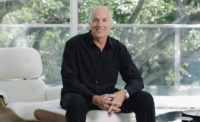A native of Mexico City, Michel Rojkind established his practice, Rojkind Arquitectos, in the sprawling metropolis in 2002. The 49-year-old architect is known for forwardthinking expressive work that pushes formal and material boundaries. Last month it was announced that Rojkind was appointed senior vice president of architecture for the rapidly expanding company WeWork, where he will be overseeing all ground-up projects. RECORD met with him in the company’s New York headquarters.
You recently moved to New York from Mexico to join WeWork. How did this come about, and what will you be doing in your new role?
After Bjarke Ingels was announced as the company’s chief architecture officer, we started having some conversations about WeWork doing ground-up buildings in Mexico. He invited me to New York to meet with the cofounders, Adam [Neumann] and Miguel [McKelvey], and we talked about how buildings can add to and engage communities and elevate the world’s consciousness—ideas I’ve been pushing as an architect. So, in a way it was kind of a seamless move. What I’ll be doing is helping build design credibility, where the message of the company is carried out by the architecture. I’m assembling a design team within WeWork. I don’t want it to be that big—the whole idea is to have a flexible platform where we have a core team that collaborates with other designers in the places we are building. Of course, Bjarke’s overseeing everything that we’re doing.
You have a thriving practice and have had some significant commissions recently. What is happening with your office?
My office is still running in Mexico. I have a pipeline of projects that I need to finish, but I’m going to be long-distance, with my full attention here at WeWork. We’ll figure it out, because even my clients from Mexico want to do stuff with WeWork. I mean, perhaps my company could be an embassy for the company in Mexico. But, for the moment, Rojkind Arquitectos is running parallel to this.

How does the WeWork mission jibe with your design vision, and how is your design vision a good fit for where they want to go?
When I left my practice behind in Mexico, I didn’t want to feel that I was leaving my family and coming to work in a company; I wanted to feel that I was coming into another family. And I have found that we share a vision to improve our cities, improve our way of life—things that, to me, architecture has always been about. When I say it was a seamless transition, it’s because we have those same goals. But now there is a broader reach and bigger capacity to make an impact. WeWork has talented engineers and space analysts. So the questions we are asking together are: How will we apply all that WeWork has learned in nine years of working inside refurbished spaces? What are we learning from spatial and behavioral analytics? And how do we translate those things into buildings and the language we will develop for WeWork’s new phase, which is about an external face toward the city and what it can do for the community.
Your first project will be in Bentonville, Arkansas: a 200,000-square-foot building that the We Company is partnering on with the private-capital group Center City. What can you tell me about that?
Center City started working on a new development in Bentonville and wanted WeWork to come in and operate the building. We said, ‘Yeah, we can operate it, but we can also do the building.’ They liked the idea, but they had already done an RFP, and when we realized we would be displacing someone, we suggested a collaboration instead. This is an important piece: to have local collaborators in on the design process from the beginning. I hope this first project will show how open and flexible we are—even though WeWork is a huge company, we don’t want to come in and do everything ourselves. What they asked for was an office building, but we’re looking at how we can activate it with other components, like education, culture. We are asking questions like, ‘How does the building become a platform for engaging society?’ and ‘What can the building offer to this community?’ We’re learning from the history of the place, the houses and the porches, the bike trails all over Bentonville. We’re trying to be receptive to all that and then deliver a tailor-made project.





